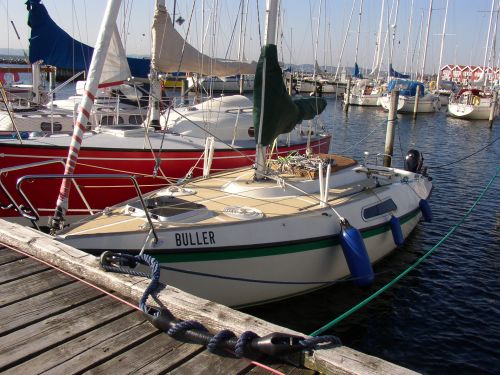Review of Drabant 21


Basic specs.

Looking for a new boat? Find a Drabant 21 or similar boat for sale
Note: the boat has also been sold to be self-made/-interiored, which means that the quality of each boat may vary.
The Drabant 21 is equipped with a fin keel. The fin keel is the most common keel and provides splendid manoeuvrability. The downside is that it has less directional stability than a long keel.
Drabant 21 can enter even shallow marinas as the draft is just about 1.15 - 1.25 meter (3.77 - 4.07 ft) dependent on the load.
An outboard motor is often used on this boat. In that case the boat will typically require a power of 2 - 3 hp, alternatively 48 - 57 lbs thrust if you prefer an electrical motor. Electric outboards are becoming popular for sailboat owners who want clean instant power with less noise and no exhaust fumes.
Sailing characteristics
This section covers widely used rules of thumb to describe the sailing characteristics. Please note that even though the calculations are correct, the interpretation of the results might not be valid for extreme boats.
What is Capsize Screening Formula (CSF)?
The capsize screening value for Drabant 21 is 2.11, indicating that this boat would not be accepted to participate in ocean races.
Sailing statistics
This section is statistical comparison with similar boats of the same category. The basis of the following statistical computations is our unique database with more than 26,000 different boat types and 350,000 data points.
What is L/B (Length Beam Ratio)?
The l/b ratio for Drabant 21 is 3.08.
The ballast ratio for Drabant 21 is 50%.
What is Relative Speed Performance?
The Relative Speed Performance for Drabant 21 is 69
Maintenance
If you need to renew parts of your running rig and is not quite sure of the dimensions, you may find the estimates computed below useful.
| Usage | Length | Diameter | ||
| Jib sheet | 6.6 m | (21.8 feet) | 10 mm | (3/8 inch) |
| Genoa sheet | 6.6 m | (21.8 feet) | 10 mm | (3/8 inch) |
| Mainsheet | 16.6 m | (54.4 feet) | 10 mm | (3/8 inch) |
| Spinnaker sheet | 14.6 m | (47.9 feet) | 10 mm | (3/8 inch) |
This section shown boat owner's changes, improvements, etc. Here you might find inspiration for your boat.
Do you have changes/improvements you would like to share? Upload a photo and describe what to look for.
We are always looking for new photos. If you can contribute with photos for Drabant 21 it would be a great help.
If you have any comments to the review, improvement suggestions, or the like, feel free to contact us. Criticism helps us to improve.
